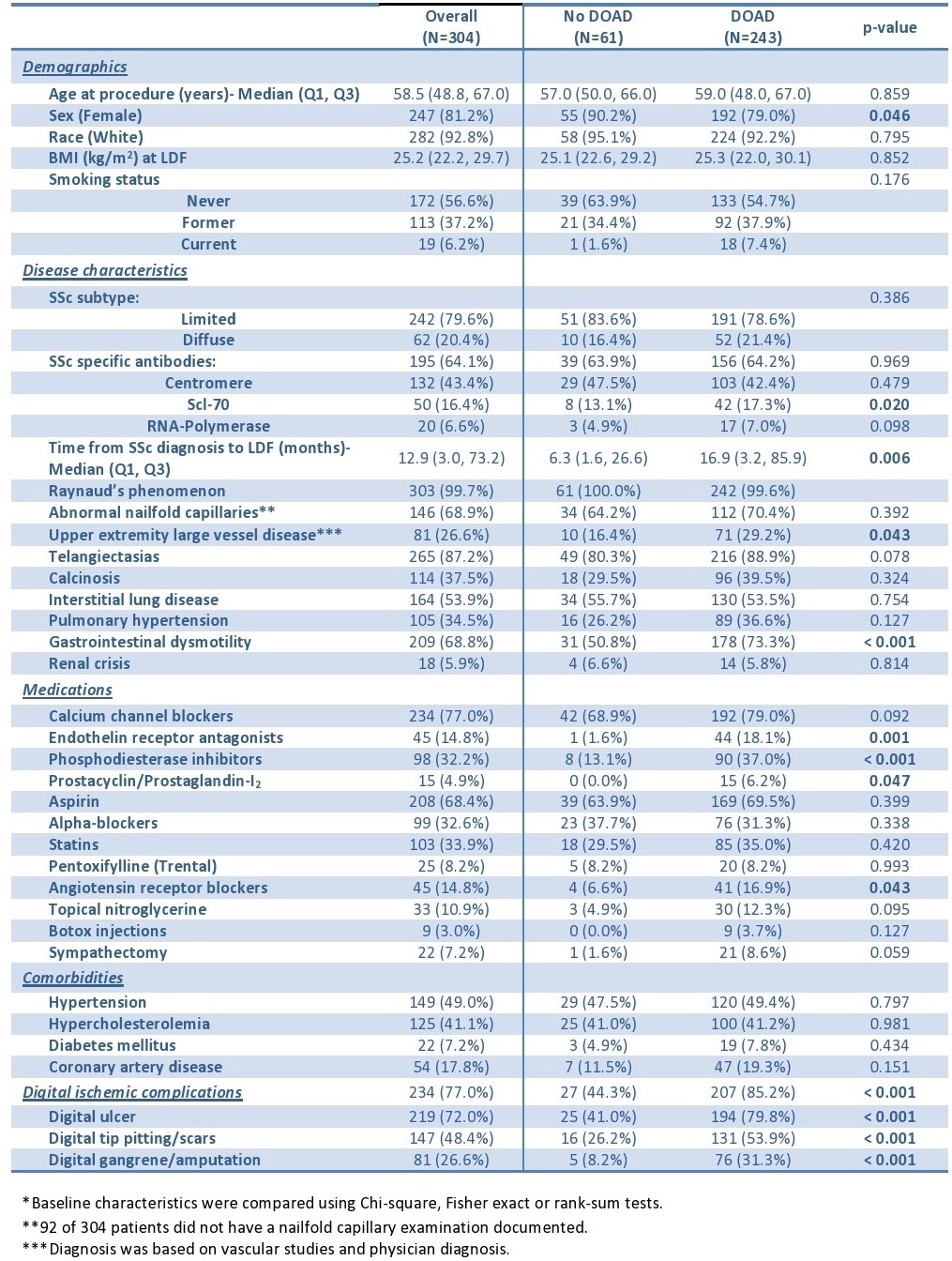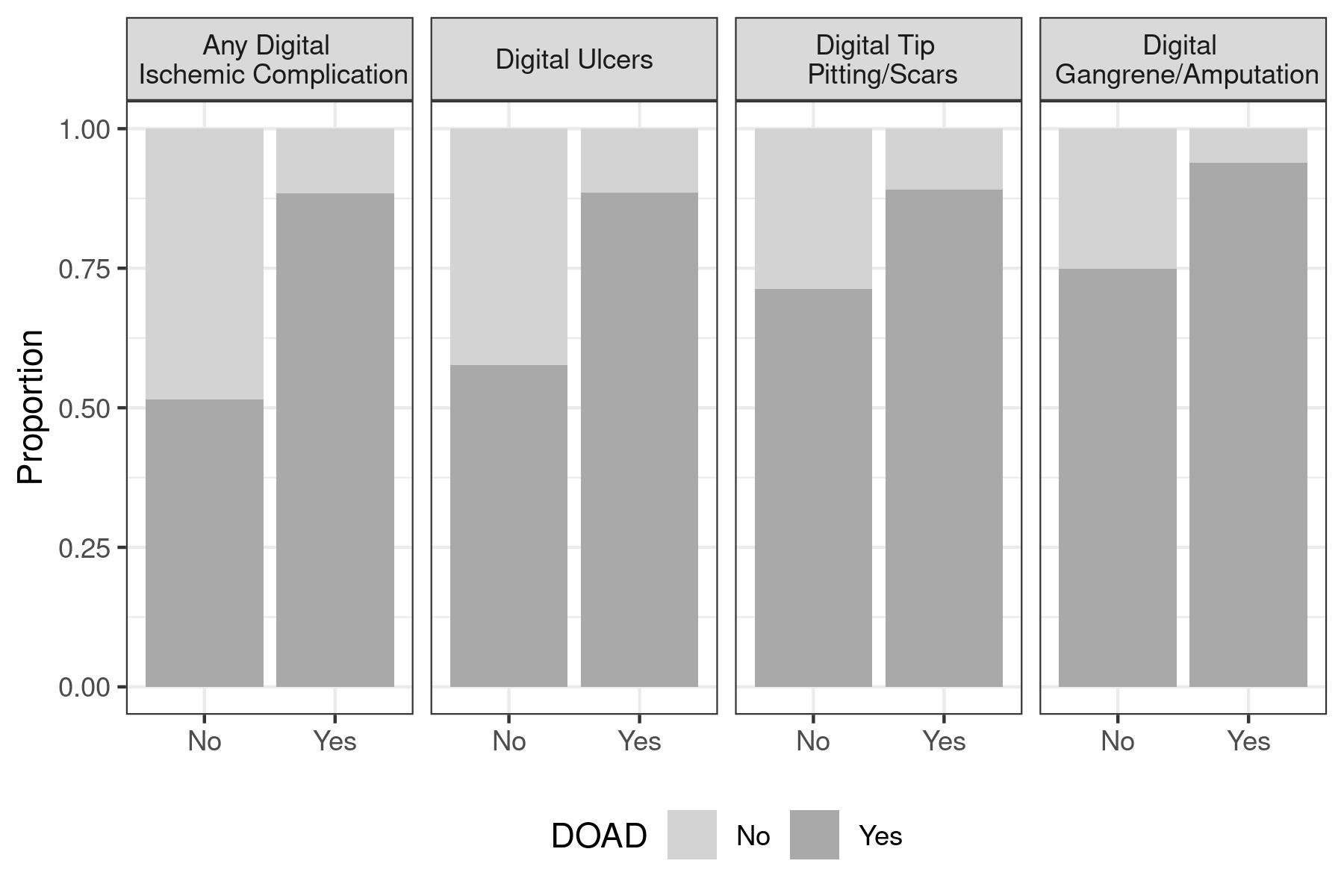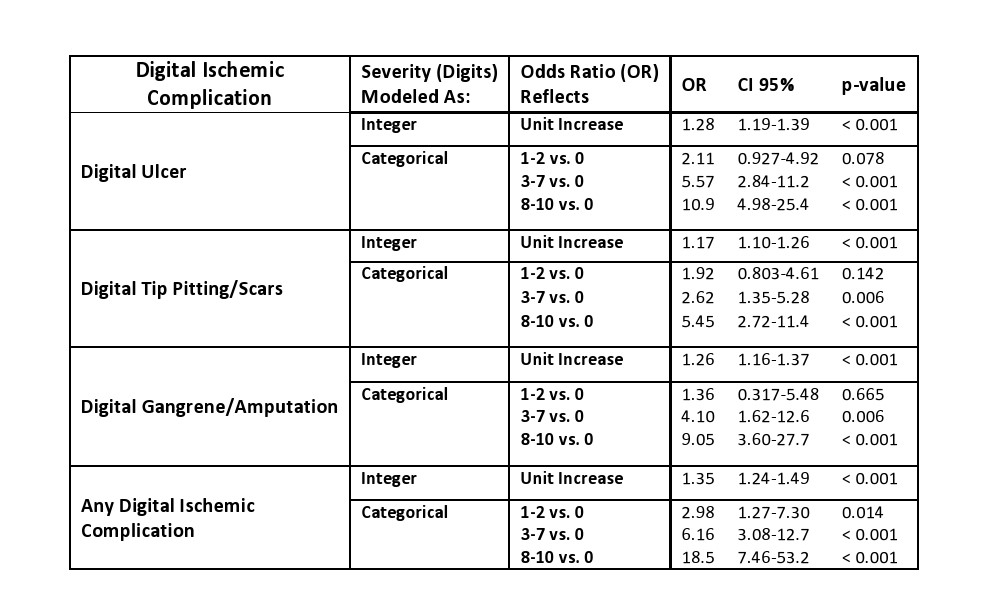Session Information
Session Type: Poster Session C
Session Time: 9:00AM-11:00AM
Background/Purpose: Vascular dysfunction is a key feature of systemic sclerosis (SSc), manifesting clinically as Raynaud’s phenomenon (RP) with or without digital ischemia. Laser doppler flowmetry (LDF) with thermal challenge is a safe, noninvasive and reproducible technique to detect digital occlusive arterial disease (DOAD) with a high sensitivity and specificity of >90% (1). The presence and associations of DOAD in SSc are not well defined. We studied the prevalence and clinical correlates of DOAD on LDF in SSc patients referred for evaluation of RP at a tertiary referral center.
Methods: Medical records of all SSc patients meeting ACR/EULAR 2013 classification criteria that underwent upper extremity vascular study with LDF between Jan 2001-Dec 2018 at our institution were retrospectively reviewed to abstract the presence or absence of DOAD. The presence of DOAD on LDF was confirmed if pre- and post-warming skin blood flow was ≤206 arbitrary units. Severity of DOAD was assessed based on number of digits involved. Demographics, clinical characteristics, and outcomes were abstracted. Risk factors associated with presence of DOAD in SSc and correlation between presence and severity of DOAD with digital ischemic complications were studied.
Results: 304 SSc patients (mean age 57.1 ± 13.3 y, 81% female, 93% Caucasian) underwent LDF during the study period. Majority had limited cutaneous SSc (lcSSc) (79.6%) and 64.1% had a positive SSc specific antibody. Cohort characteristics are described in Table 1.
On LDF, presence of DOAD was noted in 243 (79.9%) SSc patients. Of these, 78.6% had lcSSc, 42.4% had a centromere antibody (Ab), 17.3% had a Scl-70 Ab, 53.5% had interstitial lung disease, 36.6% had pulmonary arterial hypertension, and 73.3% had gastrointestinal dysmotility (GID). Of 159 DOAD patients who had their digital nailfold examined, 70.4% had nailfold capillary abnormalities. After adjusting for age/sex, GID (OR: 2.73, p < 0.001) and telangiectasia (OR: 2.83, p 0.013) were significantly associated with DOAD on LDF.
Digital ischemic complications among SSc patients with DOAD were significantly higher than among those without DOAD (79.8% vs 41.0% had digital ulcers, 53.9% vs 26.2% had pitting/scars, 31.3% vs 8.2% had gangrene/amputation; p < 0.001). (Figure 1) Increasing severity of DOAD was associated with a statistically significant increase in incidence of digital ischemic complications as presented in Table 2.
Conclusion: To our knowledge, this is the first and largest study to describe the prevalence and predictors of DOAD on LDF in a well-defined cohort of SSc patients. The high prevalence of DOAD on LDF noted in SSc related RP makes it an important tool for evaluation of microangiopathy in SSc and distinguishing it from primary RP. The presence and severity of DOAD also correlates with digital ischemic complications. Our study underscores the significance of LDF as a reliable non-invasive method for detecting DOAD and as a prognostic tool to identify patients at risk of digital ulcers that need closer follow-up and more aggressive management of their vasculopathy to prevent ischemic complications.
(1) Mahe G et al. J Vasc Surg. 2014 Apr;59(4):1051-1057.e1
 Table 1. Clinical Characteristics of 304 Systemic Sclerosis (SSc) Patients that Underwent Laser Doppler Flowmetry (LDF) with Thermal Challenge (2001-2018) Overall and by Presence or Absence of Digital Occlusive Arterial Disease (DOAD)*
Table 1. Clinical Characteristics of 304 Systemic Sclerosis (SSc) Patients that Underwent Laser Doppler Flowmetry (LDF) with Thermal Challenge (2001-2018) Overall and by Presence or Absence of Digital Occlusive Arterial Disease (DOAD)*
 Figure 1. Correlation between Presence of Digital Occlusive Arterial Disease (DOAD) on Laser Doppler Flowmetry and Digital Ischemic Complications in Systemic Sclerosis
Figure 1. Correlation between Presence of Digital Occlusive Arterial Disease (DOAD) on Laser Doppler Flowmetry and Digital Ischemic Complications in Systemic Sclerosis
 Table 2. Logistic Regression Models for the Association of Digital Ischemic Complications and Severity of Digital Occlusive Arterial Disease (DOAD) on Laser Doppler Flowmetry with Thermal Challenge
Table 2. Logistic Regression Models for the Association of Digital Ischemic Complications and Severity of Digital Occlusive Arterial Disease (DOAD) on Laser Doppler Flowmetry with Thermal Challenge
To cite this abstract in AMA style:
Radwan Y, Gunderson T, Crowson C, Liedl D, Warrington K, Wennberg P, Makol A. Digital Occlusive Arterial Disease on Laser Doppler Flowmetry Increases the Risk of Digital Ischemic Complications in Systemic Sclerosis: Results from a Single Center Referral Cohort (2001-2018) [abstract]. Arthritis Rheumatol. 2020; 72 (suppl 10). https://acrabstracts.org/abstract/digital-occlusive-arterial-disease-on-laser-doppler-flowmetry-increases-the-risk-of-digital-ischemic-complications-in-systemic-sclerosis-results-from-a-single-center-referral-cohort-2001-2018/. Accessed .« Back to ACR Convergence 2020
ACR Meeting Abstracts - https://acrabstracts.org/abstract/digital-occlusive-arterial-disease-on-laser-doppler-flowmetry-increases-the-risk-of-digital-ischemic-complications-in-systemic-sclerosis-results-from-a-single-center-referral-cohort-2001-2018/
